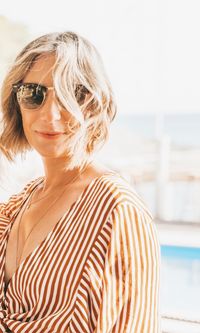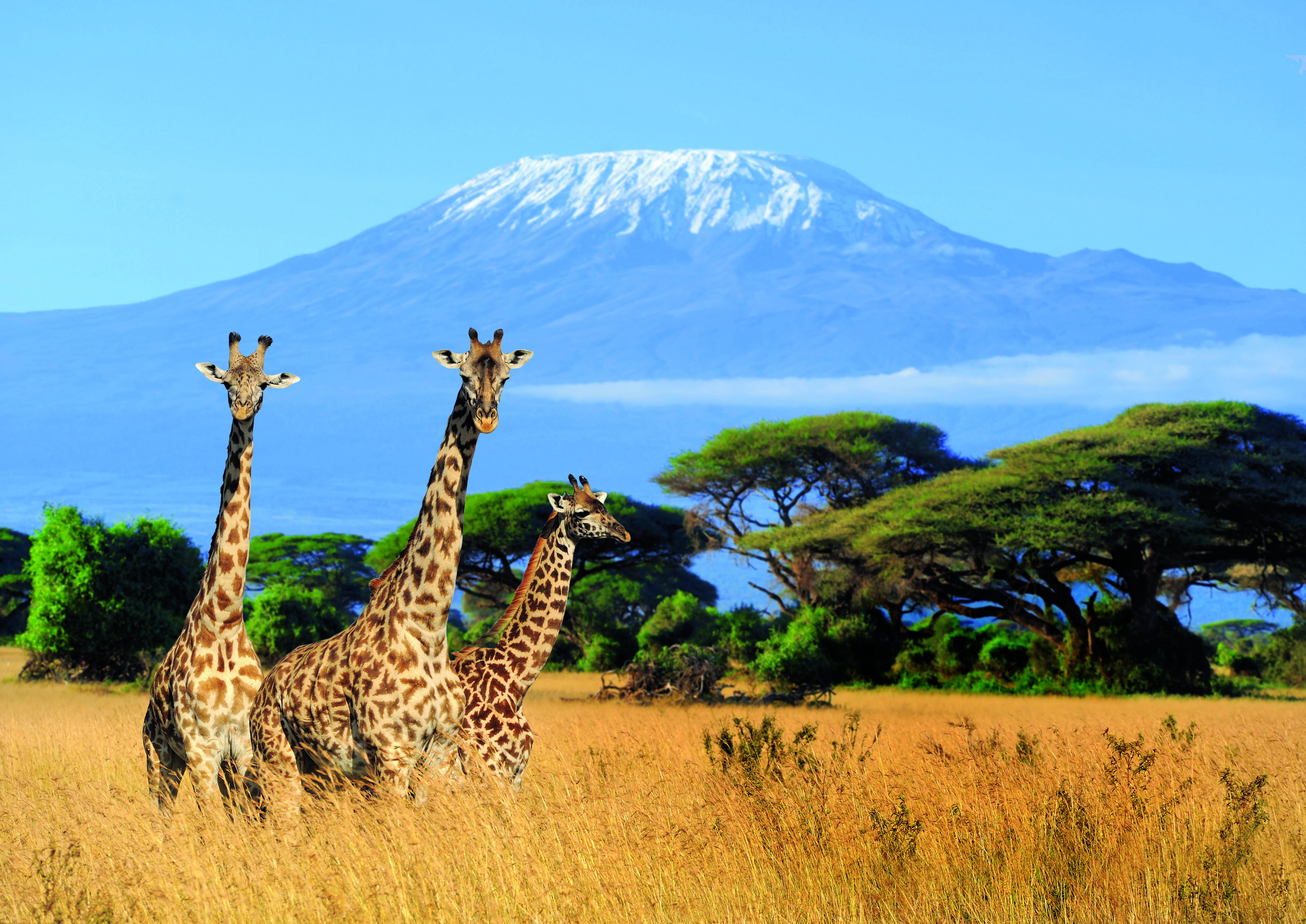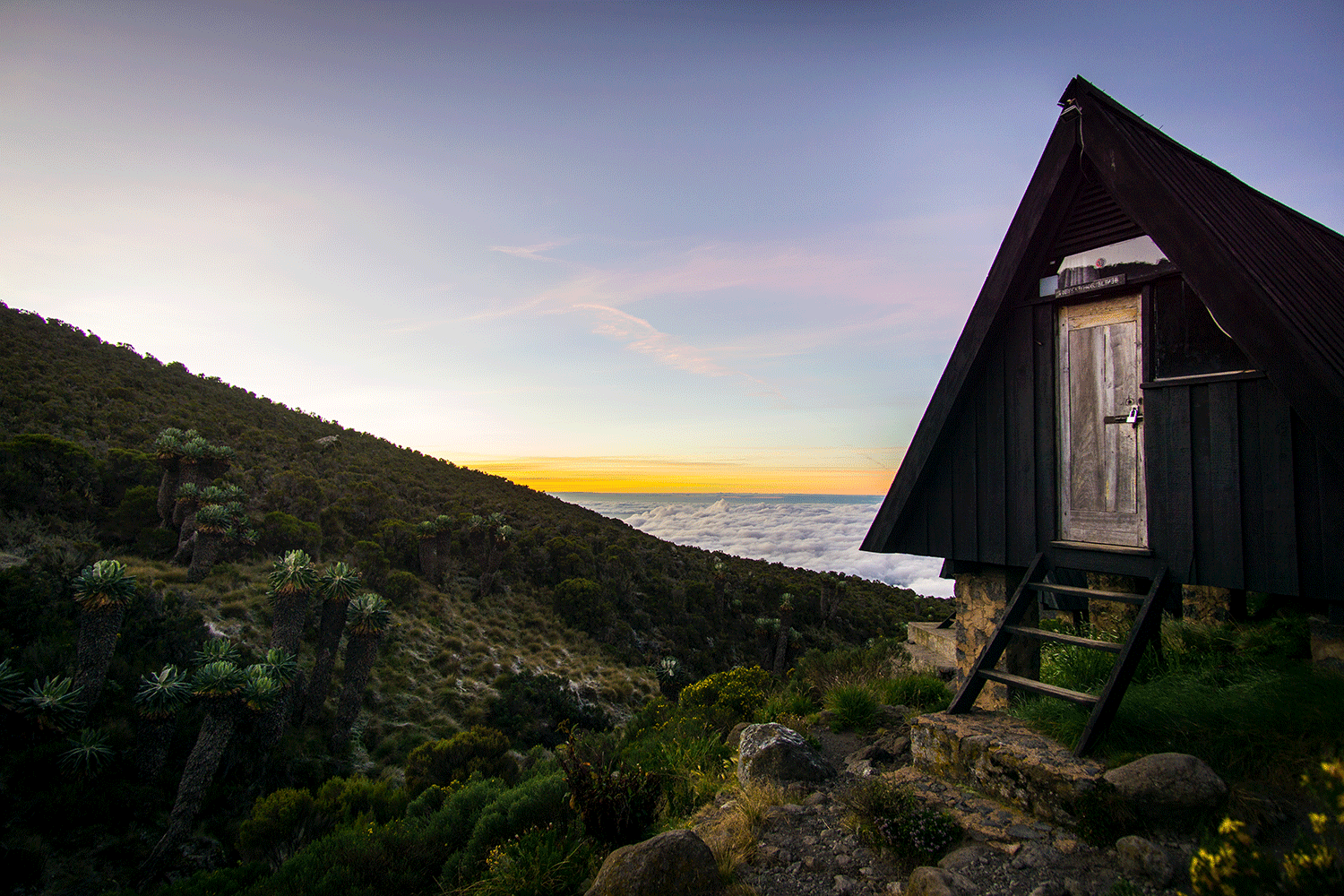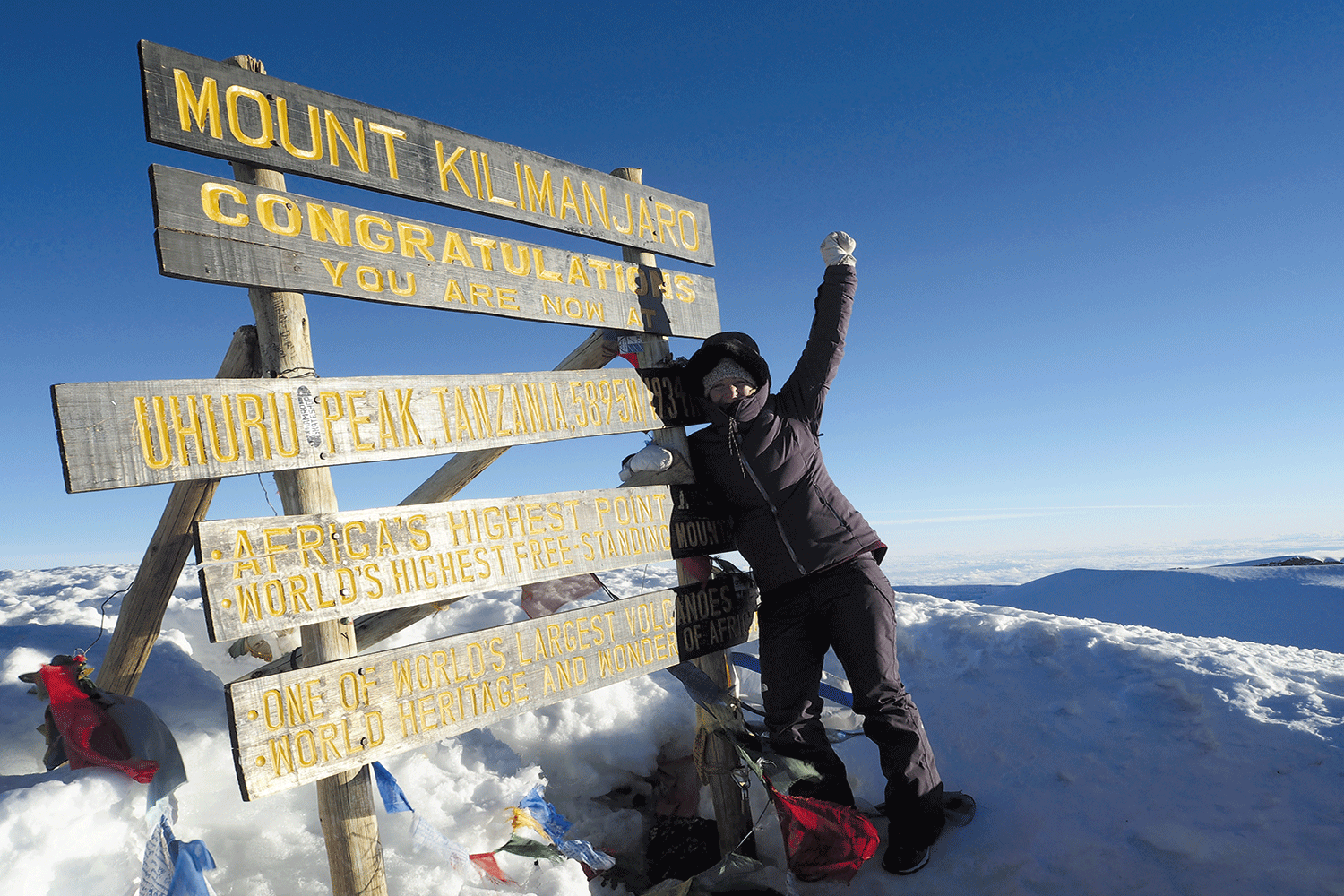To the roof of Africa: a bragging-rights adventure on Mount Kilimanjaro
Chasing an emotional high, Nicola Moyne finds empowerment on the frozen peak of Mount Kilimanjaro in Tanzania. Just don’t call it a ‘walk’…


Chasing an emotional high, Nicola Moyne finds empowerment on the frozen peak of Mount Kilimanjaro in Tanzania. Just don’t call it a ‘walk’…
It’s 2am and, despite the three layers of thermals and heavy down jacket I’m concertinaed into, I’m chilled to the bone traversing the world’s tallest freestanding mountain. For every painfully slow shuffle I make up the windswept strata of ashen, crumbly rock, I seem to slide down three more.
My balance is off and I’m starting to lag behind the group – their headlamps weaving like silent miners in a zigzag up the steep, ice-latticed terrain ahead. Right now, the rhythmic repetition of putting one foot in front of the other is all that’s keeping me from ripping off my Gore-Tex balaclava and wilfully succumbing to high-altitude delirium.
Climbing Mount Kilimanjaro, Africa’s tallest – and the world’s tenth highest – peak at 19,341ft, has been on my bucket list ever since I was plucky enough to clamber atop my parents’ retro-blue bathroom suite for a better view of the arresting sunset vistas.
Family holidays were spent caravanning in soggy Somerset, not exploring the acacia-studded savannahs of Africa. But there in urban Essex, one foot precariously balanced on the toilet seat and the other on the hot tap, each amber-streaked horizon would transport me to the Serengeti’s golden plains.
Fast-forward three decades and, like many women I know, I’m hungry for an adventure that delivers a sense of achievement rather than a fast-fading tan. So, buoyed by a Point Break binge and large glass of malbec, I impulsively book a seven-day trip to Tanzania.
My mountaineering experience starts and ends with a balmy jaunt up Snowdon last summer, but that doesn’t seem to faze me as I happily click ‘confirm’ and take a celebratory gulp. As a well-meaning friend puts it before I leave for one of the world’s seven summits, ‘If Chris Moyles got up there, you’ve got this in the bag…’ Next stop, Mount Kilimanjaro.
Celebrity news, beauty, fashion advice, and fascinating features, delivered straight to your inbox!
‘Marangu snakes its way through rich rainforest and sweet-smelling alpine meadows before the arid mountain peaks loom above’
After a nine-and-a-half-hour flight via Nairobi, I greet my multinational band of fellow climbers at the palm-fringed Mountain Resort hotel in Marangu – a lively market town lush with banana and coffee plantations at the foot of Kilimanjaro National Park.

Eleven of us have booked the trip through Intrepid Travel: four banterous Aussies (Trent, Alice, Greg and Kyle), a linen-clad Brazilian (Magda) and a cosmopolitan coterie of iPhone-tapping Europeans (Sofia, Eva, David, Michele and Monika). Banked in the bar for ‘one last round’ of Serengeti beers before our five-day trek commences, we bond over the intermittent wifi and chilly lounge, ignorant of the freezing night-time temperatures we’ll experience each night as we ascend.
Our head guide, Jacob, is a slight and softly spoken local. A former maths teacher, he exudes ‘firm but fair’ as he delivers our pre-tour briefing: ‘On the mountain, it’s safety first – no question,’ he says. ‘I want you to enjoy yourselves, but if I say you have to go down, then you go down.’ He asks if we’ve all packed crampons. We haven’t.
Ordinarily, Kilimanjaro is considered a ‘walk-up’ mountain – ie, you don’t need any fancy gear. It’s early June, though – just before peak season in Tanzania – and unusually heavy snowfall has resulted in the formation of hard, slippery ice that can become treacherous without traction cleats.
Magda, our chic Brazilian, lightens the mood by asking if there’ll be electricity en route: ‘I’ll need somewhere to charge my laptop,’ she deadpans.
We hit the Marangu trail – the most direct ascent of Kilimanjaro – at 8am the following morning. It will take five days to climb and descend via this route, which snakes its way through erica-rich rainforest, Jurassic-looking groundsel grasslands and sweet-smelling alpine meadows before the arid mountain peaks loom above.
The standard seven-to-nine-day routes are often favoured in an attempt to avoid altitude sickness, but Marangu is the only trail that doesn’t require camping.
Wooden A-frame huts that sleep four or more populate the three camps (Mandara, Horombo and Kibo) and although bijou and basic, the cabins are as close to luxury as you’re going to get. When you consider everything for camp has to be carried up by Tanzanian porters – who, despite the heavy loads balanced upon their backs and heads smile and laugh as they pass at lightning speed – it’s incredible to think that there are any home comforts to be had 15,520ft above sea level.

But what you might gain in comfort on Marangu, you lose in the struggle to acclimatise. Born from a tumultuous series of volcanic eruptions about 3 million years ago, Uhuru Peak – Kilimanjaro’s Kibo crater summit – towers over Africa’s blush-pink cloud blanket at over 19,000ft.
At this altitude, the air is so thin it can be difficult to breathe or think clearly and at least one member of the group, Eva – a chatty brunette from Belgium with an envy-inducing tan – soon starts to show signs of high altitude sickness, experiencing piercing headaches, nausea, fatigue and crippling self-doubt over whether she can reach the top.
(Top tip: Diamox can help to alleviate symptoms and Alice, a gutsy Melbourne-based doctor – the job title everyone wants to hear during a pre-brief – kindly shares her stash with some of the group. ‘If it helps, why not, right?’)
‘We plod on towards the frozen peak, propelled by sheer will and Dioralyte’
The gruelling inclines and freezing night-time temperatures prove no match for the group’s collective cheer, though. Our 27-strong team of cooks, guides and porters laughingly label us wazimu mzungu (Swahili for crazy white guys) as we indulge Greg’s ‘dad’ jokes, Kyle’s uphill dancing and David’s one-liners while singing along to Fleetwood Mac.
‘You Can Go Your Own Pace’ becomes our customised anthem as we ascend 10-15km per day, weaving first through mist-swaddled ferns in the rainforest to Mandara as majestic colobus monkeys glide across the canopies of green above, before tackling the steep, stony ravines that punctuate the path to Horombo Hut.

Exchanging jubilant jambos (hello) with passing porters, we plod towards the frozen peak, propelled on largely by will, good humour and Dioralyte. On day four, we reach Kibo – base camp.
It’s here, at 11pm, exhausted but jacked with nervous energy, that altitude sickness claims Eva, who tearfully decides to descend while the rest of us layer up to the point of limb inarticulation.
It’s heartbreaking to lose a member of the group at this stage, but after a rousing rendition of Ain’t No Mountain High Enough, our guides usher us out into the star-studded night for the final seven-hour push to the summit.
Moving pole pole (slowly, slowly), we wind upwards in single file through loose, volcanic shale and, as Jacob leads us quietly into the lunar-lit scree, I realise this isn't going to be like the previous three days – the mood has changed as dramatically as the landscape.

Tackling the steep, charcoal-grey slopes is reminiscent of being on the moon and I increasingly start to rely on the help of local guide Augustin, who sweetly takes my hand each time I fall (plural) and encourages me to catch my breath.
We stop in clam-like caves to refuel, but the banter has dissolved with our energy. I’m told that the temperature has plummeted to -30C and with my iPhone (and water) now frozen, there’s no motivational playlist to rely on. It’s sheer will power versus the mountain.
At 4am, gale-force winds pummel my face, making breathing let alone traversing volcanic boulders arduous. In the distance, I spot Trent’s left hand doggedly fixed to the top of his ridiculously impractical fedora and wonder how on earth he’s managing to do the whole thing one-handed. I still have two hours of compacted ice channels (sans crampons) to navigate on this glacier-crowned ridge and I seem to have left my usual PMA and bounce back at base camp.

My head spins from the altitude as I snake my way past Stella Point at 18,885ft, before laying eyes on Uhuru Peak – its snow-beaten summit flags whipping in the 80mph winds. As I finally shuffle my way on to the roof of Africa, dawn breaks into the same kaleidoscopic glow I’d once imagined from my parents’ bathroom window.
We all have our mountains to climb in life – physical or emotional – and as I lean against the iconic signpost to give the illusion I can still stand for my sun-drenched summit photo, I realise I wasn’t really chasing these transcendent panoramic views. It was all about making that plucky five-year-old still in me proud.
Wazimu mzungu? Maybe. And I’d do it all again in a heartbeat.
Kilimanjaro Marangu Route with Intrepid Travel starts from £1,730pp. Price includes seven nights' accommodation, transportation, meals, National Park entrance and climbing fees, as well as a complimentary sleeping bag and walking poles. Excludes flights. See intrepidtravel.com or call 0808 274 5111 for further details or to book.

Nicola Moyne is a features and travel journalist who writes and edits for publications including The Telegraph, Sunday Times Style, Financial Times, HTSI, Wallpaper*, Grazia, House & Garden and Harper’s Bazaar. When she’s not working on an article, you’ll most likely find her horse riding or sailing the wide, meandering waters of Suffolk.